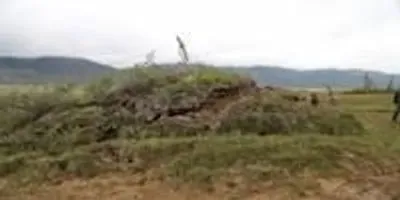 An example of cryoturbation: Ice blister near Mt. Sukakpak, AK. It formed when water became trapped between permafrost and a freezing front from above. As this internal water froze, it expanded upward, pushing the earth up and out into a mound.Photo Courtesy of: Mary Tiedeman
An example of cryoturbation: Ice blister near Mt. Sukakpak, AK. It formed when water became trapped between permafrost and a freezing front from above. As this internal water froze, it expanded upward, pushing the earth up and out into a mound.Photo Courtesy of: Mary Tiedeman
Are you unaware of what is underfoot? Soil is all around us and easy to ignore. However, locked inside is a dynamic ecosystem of amazing complexity. The Soil Science Society of America (SSSA) October 1st Soils Matter blog post explains how soil’s physical, chemical, and biological activities make soil more than dirt.
Blog author Mary Tiedeman, a scientist at Florida International University, explains. “All soils are comprised of a few basic ingredients. These include minerals, organic materials (both living and dead), and pores filled with water and gas. When combined and subjected to external forces (such as gravity and climate), soil particles react with one another.”
Related Article: The Relationship Between Soil Color and Climate
“The importance of these soil particle reactions is tremendous! They contribute to the overall health and functionality of soil systems. In the short term, physical, biological, and chemical activities work in tandem to squeeze soil materials together, pull them apart, and transport them to different locations. They contribute to nutrient cycling and to the creation and decomposition of soil organic matter. Over hundreds, thousands, or millions of years, soil processes even contribute to shaping entire landscapes.”
Scientists are working to understand the many processes at work in soils. By learning more we can be better stewards of this precious resource for future generations.
To read the entire blog post, visit https://soilsmatter.wordpress.com/2016/10/01/in-what-way-is-the-soil-dynamic-rather-than-a-lifeless-static-body/ .
Follow SSSA on Facebook at https://www.facebook.com/SSSA.soils, Twitter at SSSA_Soils. SSSA has soils information onwww.soils.org/discover-soils, for teachers at www.soils4teachers.org, and for students through 12th grade,www.soils4kids.org.
The Soil Science Society of America (SSSA) is a progressive international scientific society that fosters the transfer of knowledge and practices to sustain global soils. Based in Madison, WI, and founded in 1936, SSSA is the professional home for 6,000+ members and 1,000+ certified professionals dedicated to advancing the field of soil science. The Society provides information about soils in relation to crop production, environmental quality, ecosystem sustainability, bioremediation, waste management, recycling, and wise land use.











